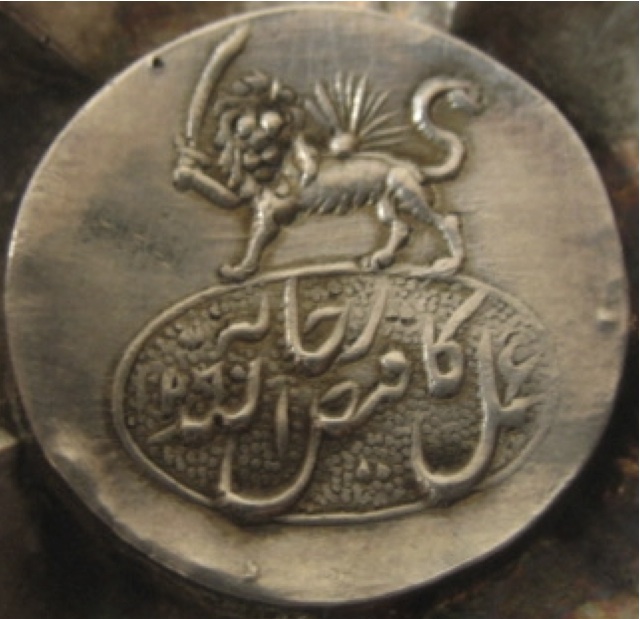-
Posts
58 -
Joined
-
Last visited
Content Type
Profiles
Forums
Blogs
Gallery
Events
Store
Posts posted by g1usxs
-
-
Does anyone have the actual link to the firman? I appreciate if anyone does to provide the link.
0 -
Thanks Nick! I knew you had the answer since you are quite the scholar! When they became purely decorative, they must have held at least some cigars. Their uniforms were quite nicely designed and were most distinctive.

Markus
The boots aren't bad either. :)
0 -
When I saw this one I was simply dazed ...
Simply amazing enamel work!!!
To say nothing about diamonds and rubies!
Interesting GB-style ribbon attachment

Ex Spada Collection.
I am simply astonished!!!

 :jumping:
:jumping:  :jumping:
:jumping:  :jumping:0
:jumping:0 -
Thank you Nick and Mitya for posting the latest pictures of aftab. :jumping:
0 -
Here is one of Fath Ali Shah..
 1
1 -
Thank you for the reply. I would love to see the original firman to see if we can decipher what it exactly says. Interesting that they are in Hermitage manuscripts collection. How did you know that Nick?
0 -
James or Nick - Do you happen to have the link or image of 1836, 1856 or 1872 firmans?
0 -
You are so right about it being the wild wild east and everything went on! LOL!
Markus
Wild wild east!! LOL!!
0 -
Nick -- Check this site for lots of persian firmans. Not necessairly OLS firmans but all sorts.
0 -
Glad you like it!
At first I didn`t even realise how many lions this millionaire had!

Regards,
Nick
The center lion enamel work is also very nicely done. Overall a perfect example of bling OLS.

I am counting 6 on this picture. :o
0 -
Very nice image Nick. Thank you.
0 -
Very nice Markus. Do you know what year was the portrait painted?
0 -
I believe we now have a good understanding as to why sun was selected as the symbol for the very first order in Persia. Sun simply represnet Fath'ali shah. He is the "sun on earth".0
-
There is much more detailed background on Lion and Sun in chapter 3 of Afsaneh's book. I highly recommend it as a source.
0 -
Afsaneh Najmabadi further writes:
"Identifying Fath'ali shah with the sun (sun king in affiliation with Jamshid) became so ubiquitous that the monarch himself used it self-referentially. When in 1819-20 Mirza Abu al-Hasan Khan Shirazi traveled to London as special envoy, Fath'ali Shah honored him by sending a dispatch of gifts, which reached him in Vienna: "A banner with the insignia of empire, ... a ribbon of an order with the picture of the sun; yes with the portrait of the emperor himself..."
0 -
I don't think that is quite correct. It is the use of Khanum (basically the feminine of Khan) that makes it female. For example, the expression for princess is actually "Shahzada Khanum", Shahzada being prince. A direct translation would consequently be "lady son of a king".
Cheers,
James
James -- I think you are right. Here is an excerpt from the book "Men with Mustaches and Men Without Beards" by Afsaneh Najmabadi:
"In this intensified visual regime, the sun, evoking the sun king for the Persianate dominion, became intimately identified with the person of Fath'ali Shah. The sun as metaphor for the ruling monarchs (including non-Iranian ones) predates the Qajars, and the expression khawrshidkulah (sun-hatted person) ws common. Although since the early Qajar period, this expression has been used to identify Catherine II of Russsia, in Safavi and early Qajar sources it was applied to any monarch. Aqa Muhammad Qajar, the fouder of the dynasty, was described through a number of sun-related metaphors, such as khawrshid'ara (adorning of the su) and khawrshid'khassiyat (having the same qualities as the sun). But it was the poets and writers of Fath'ali Shah's court who saturated the metaphoric field with the sun king. Two figures in particular delighted in inventing and proliferating sun metaphors for Fath'ali Shah: the court poet Fath'ali Khan Saba and the historian Rustam al-Hukama. Many of Saba's panegyrics center on the notion of Fath'ali Shah as sun. One of his best-known and most eloquent panegyrics, composed for the occasion of welcoming the Persian new year (nawruz) was a comparison between the sun in the sky and the sun on earth, with the opening verse:
Two suns from which the earth and time turned afresh
One entered the palace of hamal, the other the place of Kian."
1 -
"Second, the order created for Gardane, although known as The Order of the Sun in English, is known as the Nishan-i-Khurshid. Khurshid is the word for sun with a male face (note that my earlier article of 2007 mistakenly said Nishan-i-Shir)."
James -- Thank you for all the information. There is one thing that is not adding up. As far as I can tell, Khurshid is not the word for sun with male face. Khurshid has a female gender in Farsi. "Khurshid Khonom" means "lady sun". Could it be that folks are making a wrong compare/contrast between order of Khurshid and Order of Aftab? They both could reprsent a lady face however during naseraldin shah the lady sun had much more pronounced female features with attached eyebrows, etc.
0 -
Thank you Markus. One of the things that baffles me is the quality of enamel center piece of Russian manufactures. The quality of workmanship on the silver medal and the attached rays is remarkable however the center painting leaves more to be desired. Is that just me? I would have expected for such beautiful bling pieces that the center lion be a bit more regal looking.
0 -
I am confused about one thing. In the "Royal Persian Paintings", it states that this order of lion and sun (One Nick posted #162) was singed by "Muhammad Jafar" and dated 1828. Then how can Sir Malcolm receive this in 1810? What am i missing? :speechless:
0 -
Hi Nick..
Thank you for the image. THe one you are showing is exactly the same maker mark that Markus was refering to. We are still trying to decipher whether the maker is (Ya)shahshahi or (Na)shahshai or some derivative of that.
All an all, we have to add one additional persion maker to the list of persian manufacturers that Markus had put up earlier.
0 -
Markus -- Still the first two letters of Mashahshahi is questioable. I need to check with few people. It could be (Ya)shahshahi or (Na)shahshai. It is really hard to decipher.
I tried posting the image of enamel painting and the file was too large. I have to ask you later to post it for me. Thanks!!
0 -
Here is an example of Faiz Allah hallmark:
 0
0 -
I have a copies of the firmans or regulations for two of the reorganisations of the order. Apart from that, other more available references which you may like to try and find wherever you are located if you can. Alas, some of them may a little hard to access in the USA:
L.Brasier and J.L. Brunet, Les Ordres Persans, Actualites Diplomatiques & Coloniales, Arthus Bertrand et Beranger, Paris, 1902.Persia: Military Attache’s Intelligence Summary No. 12, Period 24th– 30thMarch, 1947. E 3084/17/34. Iran Political Diaries, 1881-1965, Volume 13, p. 300. India Office Records, British Library, St Pancras, London.Piemontese, Angelo M., The Statutes of the Qajar Orders of Knighthood.East and West Quarterly, New Series, Volume 19, Nos 3-4, September – December 1969, Instituto Italiano per il Medio ed Estremo Oriente (IsMEO), Rome, 1969.Rosignoli, Guido, Ribbons of Orders, Decorations and Medals. Blandford Press Ltd., Poole, Dorset, 1976.Stiot, Commissaire General R.D. Les Ordres du Croissant Turc et du Soleil Levant en Perse ou deux influences rivales en Orient,Revue Belge d’Histoire Militaire, XVI-7/8, Bruxelles, 1966.Wright, Sir Denis, “Sir John Malcolm and the Order of the Lion and Sun”.Iran, Volume XVII, pp 135-141, The British Institute of Persian Studies, London, 1979.Wright, Denis, “The Order of the Lion and Sun”. Short Notices,Iran, Volume XIX, pp 179-180, The British Institute of Persian Studies, London, 1981.Cheers,
James
James -- thank you so much for this information.
0 -
James --
Thank you for the wealth of information. Your background on this topic is very impressive and helpful. Is it possible to get the references for your information? I like to further understand the history beyond this order.
0




Persia - Order of the Lion and the Sun
in Middle East & Arab States
Posted
Congratulations Markus. Beautiful. :jumping: